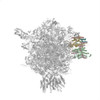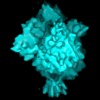 Yorodumi
Yorodumi+ Open data
Open data
- Basic information
Basic information
| Entry | Database: EMDB / ID: EMD-1143 | |||||||||
|---|---|---|---|---|---|---|---|---|---|---|
| Title | Structure of the E. coli protein-conducting channel bound to a translating ribosome. | |||||||||
 Map data Map data | EM map of the E.coli proten-conducting channel bound to a translating ribosome | |||||||||
 Sample Sample |
| |||||||||
| Function / homology |  Function and homology information Function and homology information: / cell envelope Sec protein transport complex / protein transport by the Sec complex / intracellular protein transmembrane transport / protein-transporting ATPase activity / SRP-dependent cotranslational protein targeting to membrane, translocation / signal sequence binding / stringent response / ornithine decarboxylase inhibitor activity / transcription antitermination factor activity, RNA binding ...: / cell envelope Sec protein transport complex / protein transport by the Sec complex / intracellular protein transmembrane transport / protein-transporting ATPase activity / SRP-dependent cotranslational protein targeting to membrane, translocation / signal sequence binding / stringent response / ornithine decarboxylase inhibitor activity / transcription antitermination factor activity, RNA binding / protein secretion / misfolded RNA binding / Group I intron splicing / protein transmembrane transporter activity / RNA folding / membrane => GO:0016020 / transcriptional attenuation / endoribonuclease inhibitor activity / positive regulation of ribosome biogenesis / RNA-binding transcription regulator activity / protein targeting / translational termination / negative regulation of cytoplasmic translation / four-way junction DNA binding / DnaA-L2 complex / translation repressor activity / negative regulation of translational initiation / regulation of mRNA stability / negative regulation of DNA-templated DNA replication initiation / mRNA regulatory element binding translation repressor activity / positive regulation of RNA splicing / assembly of large subunit precursor of preribosome / cytosolic ribosome assembly / response to reactive oxygen species / regulation of DNA-templated transcription elongation / ribosome assembly / transcription elongation factor complex / transcription antitermination / DNA endonuclease activity / intracellular protein transport / regulation of cell growth / DNA-templated transcription termination / response to radiation / maintenance of translational fidelity / mRNA 5'-UTR binding / regulation of translation / large ribosomal subunit / ribosome biogenesis / transferase activity / ribosome binding / ribosomal small subunit biogenesis / ribosomal small subunit assembly / 5S rRNA binding / ribosomal large subunit assembly / small ribosomal subunit / small ribosomal subunit rRNA binding / large ribosomal subunit rRNA binding / cytosolic small ribosomal subunit / cytosolic large ribosomal subunit / cytoplasmic translation / tRNA binding / negative regulation of translation / rRNA binding / structural constituent of ribosome / ribosome / translation / response to antibiotic / negative regulation of DNA-templated transcription / mRNA binding / protein homodimerization activity / DNA binding / RNA binding / zinc ion binding / membrane / plasma membrane / cytosol / cytoplasm Similarity search - Function | |||||||||
| Biological species |  | |||||||||
| Method | single particle reconstruction / cryo EM / Resolution: 14.9 Å | |||||||||
 Authors Authors | Mitra K / Schaffitzel C / Shaikh T / Tama F / Jenni S / Brooks III CL / Ban N / Frank J | |||||||||
 Citation Citation |  Journal: Nature / Year: 2005 Journal: Nature / Year: 2005Title: Structure of the E. coli protein-conducting channel bound to a translating ribosome. Authors: Kakoli Mitra / Christiane Schaffitzel / Tanvir Shaikh / Florence Tama / Simon Jenni / Charles L Brooks / Nenad Ban / Joachim Frank /  Abstract: Secreted and membrane proteins are translocated across or into cell membranes through a protein-conducting channel (PCC). Here we present a cryo-electron microscopy reconstruction of the Escherichia ...Secreted and membrane proteins are translocated across or into cell membranes through a protein-conducting channel (PCC). Here we present a cryo-electron microscopy reconstruction of the Escherichia coli PCC, SecYEG, complexed with the ribosome and a nascent chain containing a signal anchor. This reconstruction shows a messenger RNA, three transfer RNAs, the nascent chain, and detailed features of both a translocating PCC and a second, non-translocating PCC bound to mRNA hairpins. The translocating PCC forms connections with ribosomal RNA hairpins on two sides and ribosomal proteins at the back, leaving a frontal opening. Normal mode-based flexible fitting of the archaeal SecYEbeta structure into the PCC electron microscopy densities favours a front-to-front arrangement of two SecYEG complexes in the PCC, and supports channel formation by the opening of two linked SecY halves during polypeptide translocation. On the basis of our observation in the translocating PCC of two segregated pores with different degrees of access to bulk lipid, we propose a model for co-translational protein translocation. | |||||||||
| History |
|
- Structure visualization
Structure visualization
| Movie |
 Movie viewer Movie viewer |
|---|---|
| Structure viewer | EM map:  SurfView SurfView Molmil Molmil Jmol/JSmol Jmol/JSmol |
| Supplemental images |
- Downloads & links
Downloads & links
-EMDB archive
| Map data |  emd_1143.map.gz emd_1143.map.gz | 6.2 MB |  EMDB map data format EMDB map data format | |
|---|---|---|---|---|
| Header (meta data) |  emd-1143-v30.xml emd-1143-v30.xml emd-1143.xml emd-1143.xml | 14.3 KB 14.3 KB | Display Display |  EMDB header EMDB header |
| Images |  1143.gif 1143.gif | 67.6 KB | ||
| Archive directory |  http://ftp.pdbj.org/pub/emdb/structures/EMD-1143 http://ftp.pdbj.org/pub/emdb/structures/EMD-1143 ftp://ftp.pdbj.org/pub/emdb/structures/EMD-1143 ftp://ftp.pdbj.org/pub/emdb/structures/EMD-1143 | HTTPS FTP |
-Validation report
| Summary document |  emd_1143_validation.pdf.gz emd_1143_validation.pdf.gz | 317.4 KB | Display |  EMDB validaton report EMDB validaton report |
|---|---|---|---|---|
| Full document |  emd_1143_full_validation.pdf.gz emd_1143_full_validation.pdf.gz | 317 KB | Display | |
| Data in XML |  emd_1143_validation.xml.gz emd_1143_validation.xml.gz | 5.5 KB | Display | |
| Arichive directory |  https://ftp.pdbj.org/pub/emdb/validation_reports/EMD-1143 https://ftp.pdbj.org/pub/emdb/validation_reports/EMD-1143 ftp://ftp.pdbj.org/pub/emdb/validation_reports/EMD-1143 ftp://ftp.pdbj.org/pub/emdb/validation_reports/EMD-1143 | HTTPS FTP |
-Related structure data
| Related structure data |  2akhMC  2akiMC  4v4wM M: atomic model generated by this map C: citing same article ( |
|---|---|
| Similar structure data |
- Links
Links
| EMDB pages |  EMDB (EBI/PDBe) / EMDB (EBI/PDBe) /  EMDataResource EMDataResource |
|---|---|
| Related items in Molecule of the Month |
- Map
Map
| File |  Download / File: emd_1143.map.gz / Format: CCP4 / Size: 6.6 MB / Type: IMAGE STORED AS FLOATING POINT NUMBER (4 BYTES) Download / File: emd_1143.map.gz / Format: CCP4 / Size: 6.6 MB / Type: IMAGE STORED AS FLOATING POINT NUMBER (4 BYTES) | ||||||||||||||||||||||||||||||||||||||||||||||||||||||||||||||||||||
|---|---|---|---|---|---|---|---|---|---|---|---|---|---|---|---|---|---|---|---|---|---|---|---|---|---|---|---|---|---|---|---|---|---|---|---|---|---|---|---|---|---|---|---|---|---|---|---|---|---|---|---|---|---|---|---|---|---|---|---|---|---|---|---|---|---|---|---|---|---|
| Annotation | EM map of the E.coli proten-conducting channel bound to a translating ribosome | ||||||||||||||||||||||||||||||||||||||||||||||||||||||||||||||||||||
| Projections & slices | Image control
Images are generated by Spider. | ||||||||||||||||||||||||||||||||||||||||||||||||||||||||||||||||||||
| Voxel size |
| ||||||||||||||||||||||||||||||||||||||||||||||||||||||||||||||||||||
| Density |
| ||||||||||||||||||||||||||||||||||||||||||||||||||||||||||||||||||||
| Symmetry | Space group: 1 | ||||||||||||||||||||||||||||||||||||||||||||||||||||||||||||||||||||
| Details | EMDB XML:
CCP4 map header:
| ||||||||||||||||||||||||||||||||||||||||||||||||||||||||||||||||||||
-Supplemental data
- Sample components
Sample components
-Entire : co-translational E. coli 70S ribosome-nascent chain complexed wit...
| Entire | Name: co-translational E. coli 70S ribosome-nascent chain complexed with SecYEG |
|---|---|
| Components |
|
-Supramolecule #1000: co-translational E. coli 70S ribosome-nascent chain complexed wit...
| Supramolecule | Name: co-translational E. coli 70S ribosome-nascent chain complexed with SecYEG type: sample / ID: 1000 / Number unique components: 8 |
|---|
-Supramolecule #1: 30S
| Supramolecule | Name: 30S / type: complex / ID: 1 / Name.synonym: small subunit / Recombinant expression: No / Ribosome-details: ribosome-prokaryote: SSU 30S |
|---|---|
| Source (natural) | Organism:  |
-Supramolecule #2: 50S
| Supramolecule | Name: 50S / type: complex / ID: 2 / Name.synonym: large subunit / Recombinant expression: No / Ribosome-details: ribosome-prokaryote: LSU 50S |
|---|---|
| Source (natural) | Organism:  |
-Macromolecule #1: A-site tRNA
| Macromolecule | Name: A-site tRNA / type: rna / ID: 1 / Classification: OTHER / Structure: DOUBLE HELIX / Synthetic?: No |
|---|---|
| Source (natural) | Organism:  |
-Macromolecule #2: P-site tRNA
| Macromolecule | Name: P-site tRNA / type: rna / ID: 2 / Classification: OTHER / Structure: DOUBLE HELIX / Synthetic?: No |
|---|---|
| Source (natural) | Organism:  |
-Macromolecule #3: E-site tRNA
| Macromolecule | Name: E-site tRNA / type: rna / ID: 3 / Classification: OTHER / Structure: DOUBLE HELIX / Synthetic?: No |
|---|---|
| Source (natural) | Organism:  |
-Macromolecule #4: mRNA
| Macromolecule | Name: mRNA / type: rna / ID: 4 / Classification: OTHER / Structure: SINGLE STRANDED / Synthetic?: Yes |
|---|---|
| Source (natural) | Organism:  |
-Macromolecule #5: protein-conducting channel
| Macromolecule | Name: protein-conducting channel / type: protein_or_peptide / ID: 5 / Name.synonym: translocon, SecYEG / Number of copies: 2 / Oligomeric state: dimer of heterotrimer / Recombinant expression: Yes |
|---|---|
| Source (natural) | Organism:  |
| Recombinant expression | Organism:  |
-Macromolecule #6: nascent chain
| Macromolecule | Name: nascent chain / type: protein_or_peptide / ID: 6 / Details: Strep-II-FtsQ-SecM construct / Recombinant expression: Yes |
|---|---|
| Source (natural) | Organism: unidentified (others) / synonym: translocon |
-Experimental details
-Structure determination
| Method | cryo EM |
|---|---|
 Processing Processing | single particle reconstruction |
| Aggregation state | particle |
- Sample preparation
Sample preparation
| Vitrification | Cryogen name: ETHANE / Chamber humidity: 90 % / Chamber temperature: 93 K / Instrument: HOMEMADE PLUNGER Details: Vitrification instrument: two sided blotting plunger Method: Blot for 2 seconds before plunging |
|---|
- Electron microscopy
Electron microscopy
| Microscope | FEI TECNAI F30 |
|---|---|
| Temperature | Average: 93 K |
| Date | Mar 9, 2004 |
| Image recording | Category: FILM / Film or detector model: KODAK SO-163 FILM / Digitization - Scanner: ZEISS SCAI / Digitization - Sampling interval: 14 µm / Number real images: 385 / Average electron dose: 11 e/Å2 / Od range: 1.2 / Bits/pixel: 12 |
| Electron beam | Acceleration voltage: 300 kV / Electron source:  FIELD EMISSION GUN FIELD EMISSION GUN |
| Electron optics | Calibrated magnification: 39000 / Illumination mode: FLOOD BEAM / Imaging mode: BRIGHT FIELD / Cs: 2.26 mm / Nominal defocus max: 4.3 µm / Nominal defocus min: 1.5 µm / Nominal magnification: 39000 |
| Sample stage | Specimen holder: Cryo stage / Specimen holder model: OTHER |
| Experimental equipment |  Model: Tecnai F30 / Image courtesy: FEI Company |
- Image processing
Image processing
| CTF correction | Details: defocus groups |
|---|---|
| Final reconstruction | Applied symmetry - Point group: C1 (asymmetric) / Algorithm: OTHER / Resolution.type: BY AUTHOR / Resolution: 14.9 Å / Resolution method: FSC 0.5 CUT-OFF / Software - Name: SPIDER package Details: The falloff of Fourier amplitudes toward higher spatial frequencies was corrected using the x-ray solution scattering intensity distribution of 70S ribosomes from E. coli during each round of refinement Number images used: 53325 |
| Final angle assignment | Details: SPIDER: theta 15 degrees, phi 15 degrees |
-Atomic model buiding 1
| Details | Protocol: normal mode-based flexible fitting. Fitting of SecYEG atomic model into isolated EM density of protein-conducting channels |
|---|---|
| Refinement | Space: REAL / Protocol: FLEXIBLE FIT / Target criteria: correlation coefficient |
| Output model |  PDB-2akh:  PDB-2aki:  PDB-4v4w: |
-Atomic model buiding 2
| Details | Protocol: normal mode-based flexible fitting. Fitting of SecYEG atomic model into isolated EM density of protein-conducting channels |
|---|---|
| Refinement | Space: REAL / Protocol: FLEXIBLE FIT / Target criteria: correlation coefficient |
| Output model |  PDB-2akh:  PDB-2aki:  PDB-4v4w: |
-Atomic model buiding 3
| Software | Name: RSR2000 |
|---|---|
| Details | Protocol: real space refinement |
| Refinement | Space: REAL / Protocol: RIGID BODY FIT / Target criteria: R-factor |
| Output model |  PDB-2akh:  PDB-2aki:  PDB-4v4w: |
-Atomic model buiding 4
| Software | Name: RSR2000 |
|---|---|
| Details | Protocol: real space refinement |
| Refinement | Space: REAL / Protocol: RIGID BODY FIT / Target criteria: R-factor |
| Output model |  PDB-2akh:  PDB-2aki:  PDB-4v4w: |
 Movie
Movie Controller
Controller


















 Z (Sec.)
Z (Sec.) Y (Row.)
Y (Row.) X (Col.)
X (Col.)





















